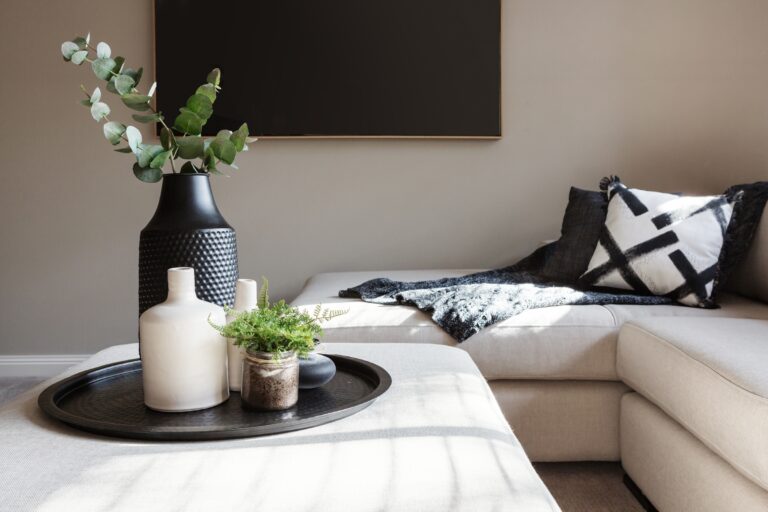Launching an interior design business is a great way to pursue your creative passions in a professional capacity, and it can also come with significant financial benefits. However, like most entrepreneurial ventures, transforming your design skills into a lucrative income stream requires an up-front investment.
So, what exactly do you need in order to start your interior design business? And what areas and elements should you focus on to maximize your investment?
Let’s dive in and find out.
And when you have time, be sure to also check out our guides to starting an interior design business and starting an e-design business.
Table of Contents
How much does it cost to start an interior design business?
There’s no black-and-white, cookie-cutter answer to this question. The number will depend on a variety of factors, including your target market, geographic area, services offered, and more. Around $1000 should get you started, covering a very basic website setup and business incorporation.
If you’re focusing solely on e-design, for example, your overhead costs may be on the lower end of the spectrum. Whereas, if you’re gunning for bigger, on-site projects, you may have to splurge for more resources, from software to staff.
Your costs will also depend on your level of expertise. Are you ready to hit the ground running designing stunning spaces for your clients? Or do you need to invest in some training first? Keep in mind that there’s tons of free info available online and networking with designers can be more useful than high-priced programs.
You also need to establish whether you can realistically achieve your business goals within an existing workspace (which might just be your dining room table!) or if you’ll need to invest in an office space where you can collaborate with employees, greet clients, store samples, and accept deliveries.
Interior design business startup costs
In order to help you estimate your initial startup costs, we’ve pulled together price ranges for the most common and essential costs for starting an interior design business, including registration and licensing, software, workspace supplies, branding, marketing, and education.
1. Registering, licensing, and insuring
Before launching your interior design business, it’s crucial to take care of the legal requirements. Depending on your location, you may need to register your business as an LLC, S Corp, or Sole Proprietorship. Some states or countries also require specific interior design certifications or permits, so be sure to check with local authorities to stay compliant.
Insurance is another key factor to protect your business from unexpected risks. Consider investing in:
- General liability insurance – Covers accidents, property damage, and potential lawsuits.
- Business insurance – Protects your operations, assets, and any physical workspace.
- Worker’s compensation insurance – Essential if you plan to hire employees or subcontractors.
- Equipment insurance – Safeguards valuable tools like laptops, software, and design equipment.
Additionally, legal fees can add up, but they’re essential for drafting airtight contracts and agreements with clients and subcontractors. You’ll need an attorney to draft a legal contract that you can use with all of your clients. Then, upload the contract template into your interior design software and send it out for e-signatures when you get new projects.
Taking care of these details early means fewer headaches later and a stronger foundation for growing your business.
Legal costs: $200-$2000+ annually
Necessity level: Requirements vary by location
2. Interior design software
Interior designers rely on software to bring their visions to life, whether it’s creating mood boards, drafting floor plans, sourcing products, or managing client projects. The good news? There are software options to fit every budget, from free tools like Coohom and SketchUp that cover basic needs to more advanced, feature-rich platforms.
You should try to consolidate your software as much as possible. If you have a lot of different tools, your monthly costs will be higher. Do your research and find a platform that offers most of what you need.
You can find all-in-one solutions like DesignFiles which offers both design, management, and client communication features to help reduce monthly costs and speed up project workflows.
By choosing the right software combination, you can enhance your productivity while keeping expenses under control.
Software costs: $0-$100 monthly
Necessity level: Required
3. Workspace supplies
Your workspace requirements will depend on the specifics of your business. In addition to a computer and/or laptop, you may also need basic office supplies and furniture, including a desk and chair, shelving, filing cabinets, a printer, paper, pens, business cards, etc.
If you plan to work with clients in person, you’ll want a warm, inviting office that not only reflects your personal brand, but makes your guests feel comfortable. You may also want to consider storage solutions for samples and swatches you want to have on hand.
If you don’t have space for a home office, your workspace costs may extend to include rent and utilities.
Workspace costs: $500-$3000 initially, with recurring expenses for commercial rentals
Necessity level: Optional depending on your business model (virtual design has less requirements)
4. Branding
Branding your interior design business involves key elements such as logos, websites, and social media account setup. Your costs will largely depend on whether you choose to handle these tasks yourself or hire professionals.
Opting for a DIY approach can help you save money upfront, but it requires time, effort, and a learning curve. On the other hand, hiring branding experts ensures a polished, professional image—but at a higher cost. It’s worth considering that if your DIY efforts don’t achieve the desired results, you may end up spending more to have a professional revamp your brand later on.
If your budget allows, investing in professional branding from the start can be a cost-effective way to establish a strong, cohesive brand identity and stand out in the competitive interior design industry.
Branding costs: $200-$5000+
Necessity level: Required, but DIY option is available
5. Marketing
Marketing your interior design business can be done through various channels, including social media, search engines, email marketing, and in-person events. Just like branding, handling your marketing efforts yourself can help reduce costs.
A well-rounded marketing strategy often includes paid advertising on platforms like Facebook and Instagram, along with boosted posts to expand your reach. Even if you’re managing your marketing independently, it’s essential to allocate funds for these efforts in your monthly budget to ensure consistent visibility and audience engagement.
Make sure to focus heavily on networking, so you can get more clients and start generating more behind-the-scenes content and portfolio content. Another way to go about this without clients or projects is to post moodboards or renders that showcase your vision while teasing your services and skills.
By striking the right balance between DIY and professional support, you can build an effective marketing plan that fits your budget and business goals.
In your first year, however, you don’t need to invest in marketing. You’re better off focusing on organic, boots-on-the-ground methods. Check out our guide to networking and referrals for more.
Marketing costs: $0-5000 per month
Necessity level: Varies; free organic networking and referrals are recommended initially
6. Professional development and education
No matter how experienced you are, continuous learning is key to staying competitive in the interior design industry. Pursuing certifications, professional memberships, and continuing education courses can help you stay ahead of industry trends while also enhancing your credibility and attracting more clients.
Keep in mind that it’s not necessary to pursue formal education. If you have a passion for design, you can learn through client projects and develop your own style as you go. However, be aware that learning as you go puts you at risk for damaging your reputation early, so gather as much knowledge as you can through research, books, business coach blogs, and designer communities.
If you’re unsure how to take your skills and business to the next level, consider working with an interior design business coach. A knowledgeable coach can provide personalized guidance to help you refine your brand, improve client relationships, and scale your business effectively. Check out our guide on choosing the right coach, which includes a list of top-rated experts in the field.
While not always essential, some business owners also invest in formal education, such as a Bachelor’s Degree in Interior Design, to deepen their expertise and expand career opportunities.
By continually investing in your professional development, you can position yourself as an expert and build long-term success in the interior design industry.
Professional development costs: $1000+ per year
Necessity level: Optional; you can learn as you gain experience
Frequently asked questions
Building an interior design business requires more than purchasing licenses and software subscriptions. Before you launch, you’ll need to develop your skills and knowledge and create a business plan. Then, you’ll register your business, invest in software, and begin marketing and building your brand.
You can learn more about starting an interior design business here.
No, a postsecondary degree is not required to start an interior design business. If you already hold a degree, it will absolutely be an asset to your business. But starting college to one day own an interior design business isn’t always cost- or time-effective.
Even though degrees aren’t necessary, some areas do require a certification. It’s important to check local regulations before opening your business to ensure you have all the credentials you need to serve clients legally.
Most recurring expenses for interior designers fall under software and marketing categories. And don’t forget about your home office expenses, rent, utilities, connectivity, paper, pens, printer ink, etc.
Yes, but it may be challenging. If you can get your first few clients through word-of-mouth and use free software, you can earn enough income to cover your growth expenses.
For example, you may make $1,000 from your first client. Instead of absorbing that profit, you can put it back into your business to upgrade your software and implement branding and marketing strategies.
Ready to start your interior design business? First you need the right foundation. Check out DesignFiles, the top-rated platform for small and solo firms.


